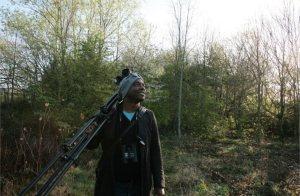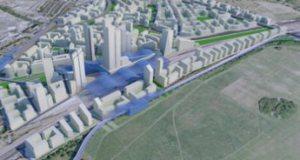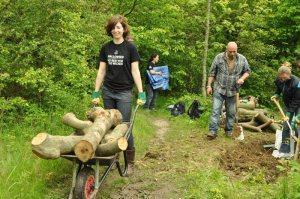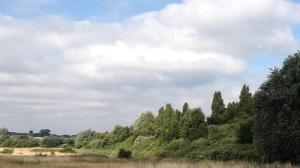 Boris Johnson’s plan to bulldoze a nature reserve risks flouting a law that recognises its’ outstanding wildlife importance.
Boris Johnson’s plan to bulldoze a nature reserve risks flouting a law that recognises its’ outstanding wildlife importance.
The London Mayor and Transport for London are currently consulting on a proposal to concrete over Scrubs Wood in west London.
However the plan is at odds with the 1987 Channel Tunnel Act which includes clauses to protect the wildlife on this railway land which is a Mecca for rare birds, voles, lizards and butterflies.
Peers in the House of Lords voted through a series of amendments forcing British Rail, as then was, to invest over £100,000 to create a nature reserve after accepting the ecological value of Scrubs Wood.
Lord Kilbracken, who died in 2006, told a Lords committee:
“The Committee must be quite well acquainted with Scrubs Wood and will not need reminding of its importance as a habitat not only of insects and plants, including trees, but in particular of birds which are my interest. Some 99 species are recorded as having been found there, many of them breeding species. But many more are migrating birds using the land on their way to and from warmer climates.
“A little wilderness has grown up alongside the railway track [and] has accidentally created a marvelous habitat for wildlife. Ornithologists and bird watchers in the area have established a kind of squatters’ right to it.”

Concrete ghetto planned to replace Scrubs Wood
A quarter of a century later Boris Johnson has launched a public consultation to erect a massive high-density and high-rise development which would involve the complete destruction of this land.
As well as appearing to contravene the spirit if not the letter of the 1987 law, TfL also plan to encroach on common land outside railway property to build an additional railway track and station for the Overground.
The common land is protected by the Wormwood Scrubs Act 1879 which forbids “permanent erections” of anything other than army rifle butts and “their related appurtenances.”
Parliament approved a series of amendments protecting Scrubs Wood in 1987 following a high-profile two-year campaign led by myself, then a young local birdwatcher.
Ecological studies presented to peers and MPs proved the area was a haven for rare flora and fauna and contained over 20 species of butterfly including Small Skipper, Essex Skipper, Large Skipper, Gatekeeper and Speckled Wood, as well as foxes, rabbits, voles, bats and a thriving colony of lizards.
‘Urban Birder’ David Lindo, star of TV birdwatching programmes (pictured above at the Scrubs) has recorded over 100 species of bird on Scrubs Wood. The area is a magnet for migrating birds including Pied Flycatcher; Dartford and Wood Warblers; Honey Buzzard; Richard’s, Rock and Tree Pipits; Osprey; Marsh Harrier; Turtle Dove; Long and Short-Eared Owls; Black Redstart; Great Grey Shrike; Nightingale; and Ortolan Bunting to name but a few. The area is also a favorite for breeding Lesser Whitethroats, has often seen breeding Skylarks, and attracts wintering Redpolls and Siskins. You can see a Guardian slideshow of Lindo at the Scrubs here.

Volunteers maintaining Scrubs Wood
Boris Johnson and TfL plan to squeeze 19,000 flats into just 155 hectares of land, including erecting large tower blocks and building over a conservation area alongside the Grand Union Canal.
The official consultation appears to be fatally-flawed because it fails to mention the plan to flatten Scrubs Wood despite several nature studies carried out by reputable consultants and environmental organisations recoding the areas’ wildlife.
There is only one brief mention of wildlife in the consultation document, which is misleadingly presented as an asset not land ear-marked for destruction. This undermines the whole consultation process.
The document says: “The unique character of the spaces would be retained, particularly for wildlife and recreational use, and new high quality green spaces would be created for the benefit of existing and future residents.” However it is clear from the plans that developers intend to build over the whole of Scrubs Wood, eradicating all wildlife that lives there.
The public consultation, which ends on 6th September, proposes a ridiculously short timescale from consultation to construction. TfL plan to have completed nine steps in the planning process by “early 2014.”

Scrubs Wood this spring
The Mayor plans an extraordinarily dense development comparable to Canary Wharf and justifies high-risk blocks as a “landmark.”
Boris has embarked on the project even though there is no planning framework to provide an overarching strategic vision for the land. City Hall are currently cobbling together an Opportunity Area Planning Framework midway through the public consultation.
The plan to build on Scrubs Wood, if it goes ahead, looks certain to also ruin parts of the nature reserve that are on common land, which is used by local schools and maintained by Groundwork UK and Hammersmith and Fulham Council.
Scrubs Wood has been recognised by Natural England as an important site of natural significance, as well as the London Wildlife Trust. The Council has published a leaflet saying “You have a chance of seeing many species of birds (including migrating species), as well as foxes, rabbits, field voles and squirrels”, and has officially acknowledged Scrubs Wood as an “area of metropolitan importance.”
TfL’s figures in their consultation document do not appear to add up and estimates of 90,000 jobs being “created” do not tally with the small area ear-marked for businesses. The first 10,000 homes, proposed to be built within an eleven year period, are estimated to ‘create’ 10,000 jobs however the next 9,000 homes will apparently lead to 80,000 jobs.
It is probable these figures do not involve jobs being created at all but factor in guesstimates about additional economic activity for the capital as a whole rather than the Old Oak development, as well as counting existing construction workers and suppliers of materials that would be involved for a short period building the project. It is certainly a dense and concentrated development that would make College Park and Old Oak arguably the most populous ward in Britain.
The absence of any mention of social housing is likely to socially-engineer this Labour stronghold into a Conservative-supporting ward in one fell stroke. However the 19,000 new households would have the run-down Willesden High Street as their nearest shopping center.
Developers also want to include a new 40,000 all-seater stadium for Queens Park Rangers, a football club with core support around a third of that figure.
By Lester Holloway @brolezholloway
